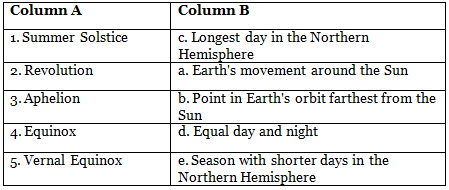Worksheet Solutions: Rotation and Revolution | Footprints Class 6: Book Solutions, Notes & Worksheets PDF Download
Q1: Multiple Choice Questions (MCQs)
(i) The movement of the Earth on its axis is known as:
(a) Revolution
(b) Rotation
(c) Equinox
Ans: (b)
The Earth's spinning on its axis is called rotation.
(ii) The Earth's axis is inclined at an angle of:
(a) 66 1/2° to its orbital plane
(b) 23 1/2° to its orbital plane
(c) 90° to its orbital plane
Ans: (b)
The Earth's axis is inclined at an angle of 23 1/2° to its orbital plane.
(iii) The circular line that separates night from day is called the:
(a) Circle of Illumination
(b) Earth's axis
(c) Great Circle
Ans: (a)
The circle that separates day and night is called the circle of illumination.
(iv) The distance between the Earth and the Sun is minimum when:
(a) The Earth is at aphelion
(b) The Earth is at perihelion
(c) The Earth is at solstice
Ans: (b)
The Earth is closest to the Sun at perihelion.
(v) The Sun's rays fall directly on the Tropic of Cancer during:
(a) Winter Solstice
(b) Summer Solstice
(c) Vernal Equinox
Ans: (b)
During the Summer Solstice, the Sun's rays fall directly on the Tropic of Cancer.
Q2: True/False
(i) A leap year has 366 days.
Ans: True
(ii) The Earth takes 23.5 hours to complete one rotation.
Ans: False
(iii) The Earth moves around the Sun in a circular orbit.
Ans: False
(iv) The spring equinox is also known as the vernal equinox.
Ans: True
(v) When the Earth, on its orbit, is at its farthest distance from the Sun, it is called aphelion.
Ans: True
Q3: Match the Column
Match the items in Column A with their corresponding descriptions in Column B: Ans:
Ans:
Q4: Fill in the Blanks
(i) The Earth's axis is inclined at an angle of ______ to its orbital plane.
Ans: 23 1/2°
(ii) The longest day in the Northern Hemisphere occurs on ______.
Ans: 21 June
(iii) The Earth completes one revolution around the Sun in ______ days and ______ hours.
Ans: 365 days and 6 hours
(iv) During the summer solstice, the region between the Arctic Circle and North Pole receives sunlight for ______.
Ans: 24 hours a day for a few months
(v) The equinox where days and nights are equal in length is called the ______ equinox.
Ans: Vernal or Spring Equinox
|
65 videos|125 docs|25 tests
|
|
65 videos|125 docs|25 tests
|

|
Explore Courses for Class 6 exam
|

|

















